FIRST YOU READ, THEN YOU WRITE
by Francis M. Nevins
Let’s begin with the unfinished business from last month, in other words with the final four uncollected Cornell Woolrich stories from 1936. During that year the steadiest publisher of his tales was Detective Fiction Weekly but the second steadiest was Argosy with six contributions in twelve months, three of them never reprinted in hardcover or paperback collections.
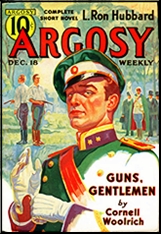
“Gun for a Gringo†from the September 5 issue is the earliest of several Woolrich stories about various macho Americans in one or another banana republic. The local color obviously stems from his memories of growing up in Mexico, and more likely than not the adventurous protagonists are based however loosely on his father Genaro Hopley-Woolrich. In “Gun for a Gringo†the narrator-hero is Steve Willoughby, a former Chicago gangster now residing in the land of Costamala and bodyguarding the country’s dictator, one- armed Presidente Savinas.
A band of scruffy revolutionaries approach Steve and offer mucho dinero if he’ll assassinate Savinas during an official banquet. Steve goes along in order to catch the conspirators red-handed but is caught playing double agent and railroaded into the state insane asylum. After enough time in the madhouse for Woolrich to take full advantage of the place’s noir potential, Willoughby escapes and, in a blaze of action, tears back to the capital trying to save El Presidente’s life.
The story works well on a simple cliffhanger level except that Woolrich gives us no reason to care whether or not the one set of corrupt politicos is ousted by the other. As usual in these Gallant Yank Abroad sagas, the racism is thicker than the heat and stronger than the plot.
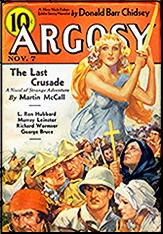
“Public Toothache Number One†from the November 7 issue is a semi-hardboiled comedy about a bill collector, obviously modeled on Jimmy Cagney, who makes a dunning call on a certain dentist just in time to be mistaken for that fellow by henchmen of the country’s most wanted criminal, who’s in hiding and suffering from a ferocious ulcerated tooth. These gangsters are so stupid they let our hero fill their hideout with carbon monoxide fumes from an auto on the pretext that it’s a form of anesthesia. Enough said.
Woolrich closed out his sales to Argosy that year with the kind of exotic adventure yarn with which the magazine was identified. “Holocaust†from the December 12 number takes place on the island of Santo Domingo during the French Revolution and deals with a bloody slave revolt.
The female lead is 18-year old Aurelie Blanchard, daughter of a plantation owner, a girl who admires Voltaire and opposes the whipping of slaves and says of blacks, echoing Shylock’s words in The Merchant of Venice about Jews, “Do they not laugh as we do, weep as we do, bleed when cut, draw breath as we do?â€
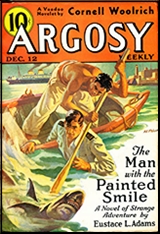
In this story the answer is No. They are a savage tide, a horde of repulsive brutes in loincloths and Jacobin caps, screaming for victims to torture, shouting Robespierre slogans and war cries and voodoo chants all in the same breath, all except Aurelie’s faithful old nurse Marthe who saves her life.
In the first and most vividly conjured-up sequences, Mon Repos is besieged. Aurelie’s mother kills herself, Aurelie herself is buried alive, and her fiancé Robert Lemaitre and the sadistic but cowardly plantation overseer Picard are taken prisoner and tortured until Aurelie turns the tables by rising from her open grave and masquerading as a zombie.
She and the two Frenchmen boil the rebel leader in a vat of wax and escape into the jungle where more terror awaits them. It’s a long and ultra-lurid tale, worthy of appearance in Thrilling Mystery alongside “Baal’s Daughter†which we dissected last month, but nowhere near as vividly written as the noir classics Woolrich set on his home turf.
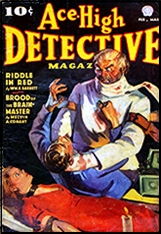
One of the least popular of the Popular Publications pulps was Ace-High Detective, which lasted just seven issues, from August 1936 through February-March 1937. Its November 1936 number included “Evil Eye,†the earliest of several stories Woolrich was to write about the encounters of various plucky and mischievous young boys with death and terror, but this one unlike its successors is played almost entirely for comedy.
Bronx plainclothesman Dan Kieran takes his 8-year-old son Danny to the Metropolitan Museum of Art to see a newly unearthed mummy with a priceless emerald eye. The orb is supposedly protected by an ancient curse that whoever tries to steal it will be blinded by the god Osiris. Danny slips away from his dad at closing time and is locked in the museum, as are two dimwits nicknamed Jojo and Donkey Mouth who plan to steal the eye during the night.
Woolrich tells almost none of this story from the viewpoint of the boy as he would in later tales of this sort. Instead he concentrates first on making us laugh as we watch the thieves’ comic interplay (which may remind sufficiently aged readers of the scenes between Jackie Gleason and Art Carney on TV’s The Honeymoners) and the bungling efforts of Danny’s father and a helpful traffic cop to break into the museum and rescue the brat, and then on making us shudder as the gory curse is fulfilled. The setting shows that Woolrich intended “Evil Eye†to be included in his book of New York Landmarks stories- — a book that for unknown reasons never came into being.
***
For the rest of this column let’s delve into a topic as far removed from Woolrich as possible, a trio of traditional detective novels from the Golden Age of that noble genre in England between World Wars. The authors I usually discuss when I’m on that subject are John Rhode and Christopher Bush, whom I’ve been reading intermittently since my teens. I don’t believe I’ve ever written a word about this month’s author. Isn’t it about time I did?
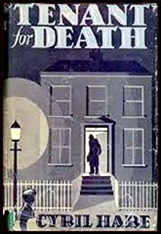
Cyril Hare was the writing byline of Alfred Alexander Gordon Clark, who was born in the county of Surrey on 4 September 1900 and, in the interstices of a legal career, produced nine highly regarded novels and more than forty short stories. His earliest novel, Tenant for Death (1937), written while he was still practicing law and before he migrated to the judicial side of the system, introduced Scotland Yard’s Inspector Mallett, a tall stout man with a taste for sumptuous lunches, not as memorable a protagonist as, say, Colin Dexter’s Inspector Morse who debuted almost forty years later but far more vivid than the all but characterless sleuths who were commonplace in British detective fiction of the Golden Age.
Lionel Ballantine, a crooked financier on the brink of exposure and arrest, is found strangled to death with a Venetian blind cord in a house in Kensington, recently rented by a paunchy full-bearded man calling himself Colin James who seems to have vanished. The murder took place shortly after the release from prison of a banker who had been innocently caught up in Ballantine’s crimes and had sworn revenge in open court after his conviction but was still behind bars when the mysterious Mr. James made his first appearance.
The banker however is hardly the sole suspect. Mallett also has to consider Ballantine’s equally corrupt secretary (who today would probably have a title like Executive Administrative Assistant), the bigamous husband of Ballantine’s mistress, a dotty nobleman who served on the crooked company’s board of directors, and several more. The traditional clues are few and far between — notably the riddles of why Ballantine was found wearing a sloppily tied green bow tie with an elegant gray suit and what happened to the umbrella with which he was last seen — but Mallett connects the dots with rare ingenuity and Hare succeeds in keeping us puzzled while playing fair all the way.
Barzun and Taylor in A Catalogue of Crime (2nd ed. 1989) called this book “a very engaging debut,†distinguished by “sound yet uncommon philosophizing….†Readers who aren’t interested in legal issues or jargon may rest assured that Tenant for Death is free of both.
***
Except for a brief colloquy in Chapter 1 on whether fishing rights are a covenant running with the land or an easement — terms which for attorneys will evoke fond or bitter memories of their Property course as first-year law students — legalisms are also absent in Hare’s second book.

I’m sure there are other detective novels in which anglers and angling are central to the plot but I can’t recall any in which the pursuit of fish figures so prominently as in Death Is No Sportsman (1938). An elaborate map of a three-mile stretch of the river Didder and its surroundings, which most readers will have to consult again and again as various characters traipse through the area, portrays footpaths, a ford, a cart track, a bridge across the river, and assorted copses and trout pools, with stately Didford Manor at the map’s northern edge and the village of Didford Magna (which is dwarfed by its companion village Didford Parva) at its southern end.
Each summer weekend the village’s only pub is taken over by four Londoners, the members of a fishing syndicate which owns the exclusive right to cast reels along this stretch of the river. All four have reasons to despise Sir Peter Packer, the wealthy owner of Didford Manor, who late one hot Saturday afternoon in June is found on a tiny piece of solid ground known as the Tump with a bullet through his eye that took most of his brains with it when it exited. Suspects besides the four fishermen include the young wife of the syndicate’s senior member, the even younger wife of odious Sir Peter, a young man from the village whose fiancée Sir Peter had (as we used to say) knocked up, and — perhaps — the rector’s unspeakable wife and the local doctor.
Almost halfway through the novel Scotland Yard in the person of Inspector Mallett is called into the case, which is labyrinthine to the max and brim-full of fishing lore. Dare I venture to suggest that most if not all of the dramatis personae must be Anglicans?
Whether Hare plays completely fair with the reader is uncertain. At the denouement Mallett offers several reconstructions of what happened, each positing a different killer, but it’s all a charade to pressure the real murderer into a confession without which, as Mallett freely admits to his local colleagues, there’s no real evidence against the culprit.
The authors of A Catalogue of Crime couldn’t agree on a verdict, with Wendell Hertig Taylor calling it the second best of the nine Hare novels while Jacques Barzun disliked it “because of the long windup and fumbling detection.†One can see his point: without real evidence how could Mallett reasonably identify the guilty party? But I remain uncertain about my own verdict. Who can decide when doctors disagree?
***
In Hare’s third book, the last he completed before the outbreak of World War II, Mallett appears only in the early and final chapters, but for my money it’s the finest detective novel of the trio. Suicide Exceptted (1939) opens on the last evening of the Inspector’s holiday, which he’s spending in a stately Georgian house turned mediocre country hotel, 42 miles from London.
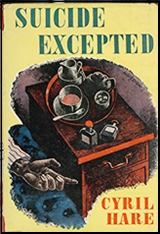
That evening in the hotel lounge, after an indigestible meal, Mallett is approached by a fellow guest, a rather eccentric old bloke named Leonard Dickinson, who hints that he may take his own life before morning. As any whodunit devotee might have guessed, he’s found dead in his bed by the maid bringing him his breakfast. The physical evidence plus Mallett’s statement convinces the coroner’s jury that Dickinson deliberately took a fatal overdose of a sleeping potion called Medinal (which I gather Hare invented out of whole cloth), and a verdict of suicide is reached.
Shortly thereafter it develops that less than a year before his death the old man had put most of his money into a life insurance policy on himself — a policy which offers a huge payout but becomes null and void if he should kill himself within a year of its inception. Faced with the prospect of destitution, Dickinson’s son Stephen and his daughter Mary, assisted by Mary’s fiancé Martin Johnson, set out to prove to the insurance company that the old gentleman was murdered by one of his fellow guests at the country hotel.
A rum assortment of guests indeed! An antiquarian parson and his wife, a young couple spending an illicit night, a mystery man who stayed confined to his room, a Lincolnshire dowager and her mentally challenged son, a gas company executive rendezvousing with a blackmailer, and of course Mallett himself and the decedent.
Most of the novel follows various combinations of the three amateur detectives, whose sleuthing soon establishes that an incredible number of the hotel’s guests that night had motives for killing the old man. Mallett comes back into the picture and exposes the murderer, whose identity is a stunning surprise (at least to me), although later I discovered that Hare had planted all sorts of subtle pointers to the truth which aren’t apparent except on a second reading.
For some reason Barzun and Taylor weren’t impressed by this novel, calling it “one-third good, two-thirds fumbling.†Long after the end of the war, when it was first published in the U.S., Anthony Boucher in the New York Times Book Review (7 November 1954) found it “more conventional and less witty†than Hare’s postwar novels but “adroit in its manipulation of [the] three amateur detectives†and “distinguished by a plot-twist†worthy of Agatha Christie. With the last point I agree completely.
***
Hare spent the WWII years first as a judge’s marshal (somebody who sits with and performs various chores for a judicial officer), then with the Department of Public Prosecutions and finally with the Ministry of Economic Warfare. Apparently he was kept quite busy, so much so that during the war he published only one novel, Tragedy at Law (1942), which many consider his masterpiece.
With the defeat of Hitler he resumed writing a book every few years. In 1950 he was appointed a County Court judge for his native Surrey, a position he held until he died, at the all too early age of 57, on 25 August 1958. Whether he chose the title himself or his publisher came up with it when he was no longer with us, it’s equally fitting that his last novel is called Untimely Death.

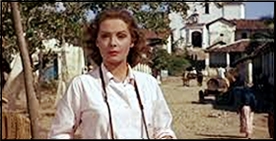
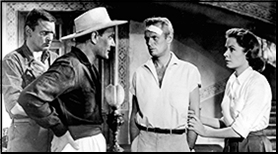
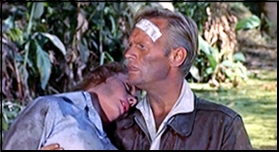
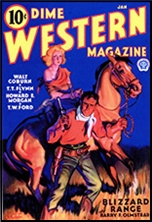

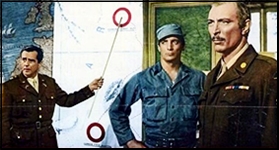
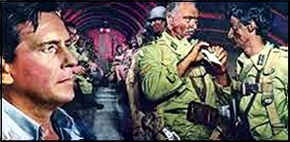
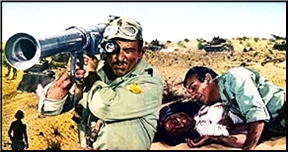
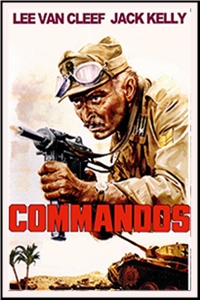








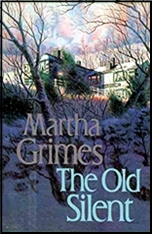
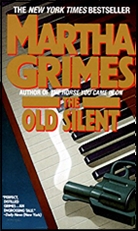
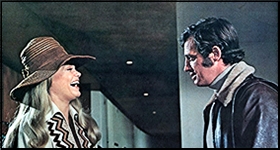
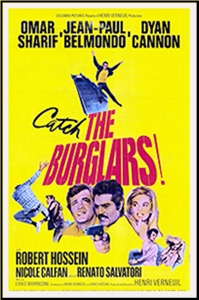
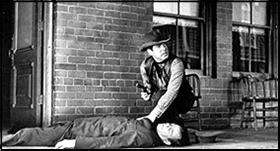
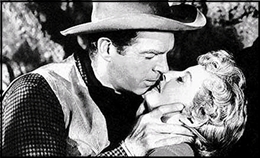
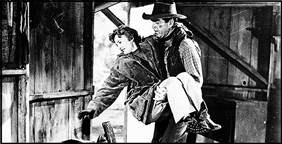
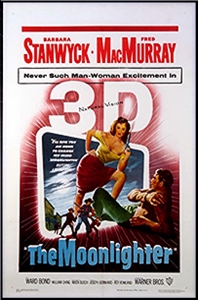 <
<
